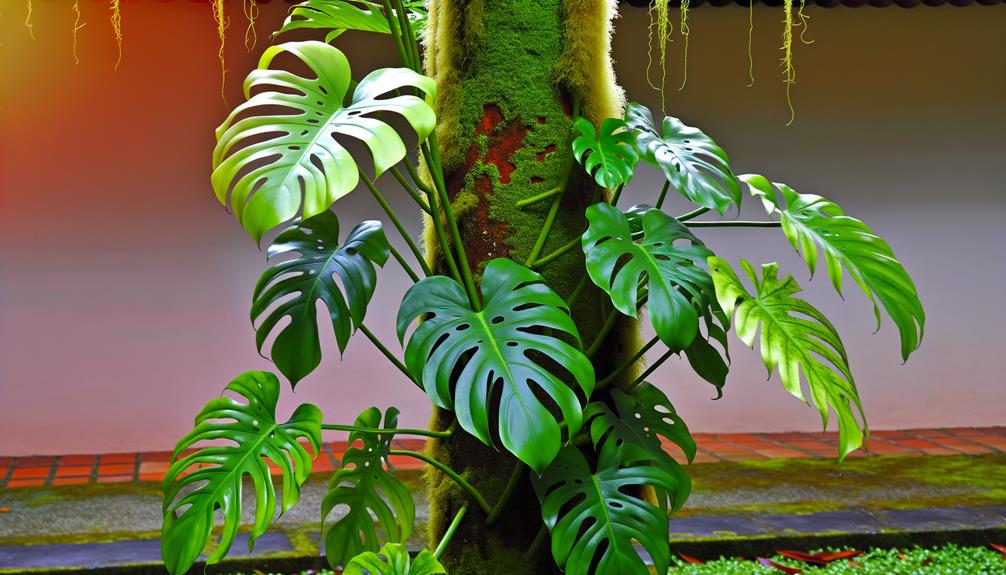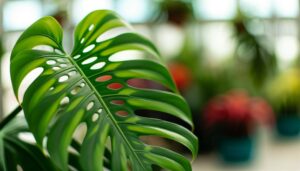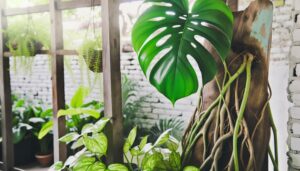Monstera Pinnatipartita Climbing Support
For best growth of your Monstera Pinnatipartita, you'll need effective climbing support. Structures like moss poles, trellises, and wall-mounted systems are ideal.
These supports mimic the plant's natural habitat, promoting vertical growth, stronger foliage, and uniform nutrient distribution. Use durable materials such as treated wood or galvanized steel for long-term stability.
Secure the structure firmly in the soil and tie vines with soft materials to avoid damage. Regular maintenance like pruning and monitoring growth will ensure your plant remains healthy.
Exploring more can provide detailed guidance on installation, care, and avoiding common pitfalls.

Key Takeaways
- Use moss poles to promote vertical growth and healthier foliage.
- Choose durable materials like treated wood or galvanized steel for support structures.
- Install climbing supports early to avoid root disturbance and ensure secure anchoring.
- Use soft materials like garden twine to tie and secure vines without causing damage.
- Regularly inspect and adjust supports to maintain optimal growth and plant stability.
Understanding Monstera Pinnatipartita
Monstera Pinnatipartita, an epiphytic aroid native to Central and South America, requires specific environmental conditions to thrive. You should maintain high humidity levels, ideally between 60-80%, to mimic its natural habitat.
Maintain consistent temperatures ranging from 65-80°F (18-27°C) and avoid cold drafts, as this species is sensitive to temperature fluctuations. Provide indirect bright light, as direct sunlight can damage the leaves.
Use a well-draining, aerated soil mix to prevent root rot and promote healthy growth. Water this plant when the top inch of soil feels dry, but make sure it never sits in waterlogged conditions.
Regularly monitor for pests like spider mites and scale insects, which can affect its health. Understanding these conditions is essential for successful cultivation.
Benefits of Climbing Support
Providing climbing support for your Monstera Pinnatipartita greatly enhances its growth and overall health. By utilizing vertical space, you ensure ideal light exposure, which is essential for photosynthesis. Additionally, climbing support helps mimic the plant's natural habitat, promoting stronger and healthier foliage. Supporting your Monstera reduces the risk of damage from sprawling growth and ensures effective nutrient distribution.
| Benefit | Description | Evidence |
|---|---|---|
| Ideal Light Exposure | Ensures leaves receive sufficient sunlight | Increased photosynthetic efficiency |
| Natural Habitat Mimicry | Encourages vigorous growth and leaf development | Healthier, larger foliage |
| Damage Prevention | Reduces breakage from unsupported stems | Decreased incidence of plant injury |
| Efficient Nutrient Distribution | Facilitates uniform nutrient uptake | Improved overall plant vitality |
Implementing climbing support is crucial for maintaining a thriving Monstera Pinnatipartita.
Choosing the Right Structure
When choosing the right structure for your Monstera Pinnatipartita, you should consider various types of climbing supports such as moss poles, trellises, and wall-mounted systems.
Analyze the material and durability of each option, ensuring it can support the plant's growth over time.
Evidence suggests that sturdy, moisture-retentive materials like moss-covered poles enhance root attachment and overall plant health.
Types of Climbing Supports
Choosing the appropriate climbing assistance for Monstera pinnatipartita is crucial, as it significantly impacts the plant's growth and overall health. To optimize growth, consider these types of climbing supports:
- Moss Poles: Provide a natural texture that encourages aerial root attachment, promoting vertical development.
- Trellises: Offer structured assistance, allowing the plant to expand both horizontally and vertically.
- Bamboo Stakes: These are versatile and can be adapted as the plant grows, providing a robust framework.
- Wall-Mounted Supports: Perfect for maximizing space, they allow the plant to ascend along walls, creating a visually appealing impact.
Each option aids Monstera pinnatipartita differently, so assess your plant's requirements and your space limitations to select the most appropriate structure.
Material and Durability
In selecting the right climbing support for Monstera pinnatipartita, it's crucial to assess the material's durability and its ability to withstand moisture and weight over time.
Opt for materials like treated wood, galvanized steel, or high-density plastic, each known for their strength and resistance to environmental stressors.
Treated wood offers a natural aesthetic but requires periodic maintenance to prevent decay. Galvanized steel provides superior strength and longevity, ideal for supporting substantial growth. High-density plastic, while lightweight, resists rot and corrosion, ensuring long-term stability.
Confirm the chosen material can support the plant's mature weight and remains unaffected by humidity. Proper selection mitigates the risk of structural failure, ensuring your Monstera pinnatipartita thrives efficiently.
Moss Poles and Stakes
Moss poles and stakes provide essential structural support that promotes Monstera Pinnatipartita to climb, mimicking its natural habitat. Utilizing moss poles, you sustain the plant's aerial roots, which latch onto the pole, promoting vertical growth and healthier foliage. Stakes assist by offering stability to the plant's stem, preventing it from toppling.
Consider these benefits:
- Enhanced Hydration: Moss retains moisture, aiding the plant's aerial roots.
- Improved Growth: Vertical support fosters robust, larger leaves.
- Disease Prevention: Elevating the plant reduces soil contact, minimizing rot risks.
- Aesthetic Appeal: Structured growth contributes to an organized, visually pleasing display.
Incorporating moss poles and stakes promotes optimal growth conditions, enhancing the Monstera Pinnatipartita's overall health and appearance.
Trellises and Ladders
When selecting trellises and ladders for your Monstera pinnatipartita, you should prioritize materials that offer both durability and support. Proper installation techniques are important to guarantee stability and promote healthy growth.
Additionally, regular maintenance and care will prevent structural issues and guarantee long-term efficacy.
Choosing the Right Material
Choosing the appropriate material for trellises and ladders guarantees your Monstera Pinnatipartita receives optimal support for healthy growth and development. When choosing materials, consider the following factors:
- Durability: Opt for materials such as treated wood or metal that can withstand humidity and provide long-term stability.
- Weight Capacity: Confirm that the material can uphold the plant's weight as it matures, preventing structural failure.
- Non-Toxicity: Select non-toxic materials to avoid harming your plant; steer clear of chemically treated wood that may release harmful substances.
- Aesthetics: Pick materials that complement your indoor or outdoor surroundings, blending harmoniously with your existing decor.
Proper Installation Techniques
To ensure your Monstera Pinnatipartita thrives, it is crucial to correctly set up trellises and ladders, following precise and evidence-based techniques. Begin by placing the support structure near the plant's base, ensuring stability. Utilize biodegradable ties to fasten the stems, preventing any damage. The support should be tall enough to accommodate growth, ideally reaching a minimum of 6 feet.
| Installation Step | Description |
|---|---|
| Positioning | Set up support close to plant base for stability. |
| Securing | Utilize biodegradable ties to connect stems without causing harm. |
| Height | Confirm support is at least 6 feet tall for proper growth. |
| Material Selection | Opt for durable, weather-resistant materials for longevity. |
Maintenance and Care Tips
Maintaining your trellises and ladders involves regular inspections for structural integrity and prompt repairs to guarantee ongoing support for your Monstera Pinnatipartita. Consistent care promotes longevity and effectiveness of the climbing aids.
Follow these key steps:
- Inspect Connections: Check all joints and fastenings for signs of wear or looseness. Tighten or replace as necessary.
- Clean Surfaces: Remove dirt, mold, and algae to prevent decay and maintain a healthy environment for your plant.
- Reinforce Anchors: Verify the anchors are secure in the soil or wall, preventing tilting or collapse.
- Monitor Plant Growth: Adjust ties and supports to accommodate growth, maintaining proper alignment and reducing strain on the plant.
Proper maintenance nurtures a stable, supportive structure for your Monstera Pinnatipartita.
Installing Support Structures
For optimal growth of your Monstera pinnatipartita, installing sturdy support structures such as trellises or moss poles is crucial. Begin by selecting a support structure that suits the plant's mature size and weight.
Moss poles provide a natural, moisture-retentive surface, promoting aerial root attachment and nutrient absorption. Trellises, on the other hand, offer robust mechanical support, ideal for larger specimens.
Insert the support structure into the pot before planting to avoid root disturbance. Position it centrally for balanced growth. Secure the base firmly in the soil to prevent tipping.
Regularly check the stability of the support, especially as the plant grows and gains weight. Proper installation fosters vertical growth, enhancing both aesthetic appeal and plant health.
Tying and Securing Vines
Stabilize each vine of your Monstera pinnatipartita is firmly fastened to the support structure to promote orderly vertical growth and prevent damage. Using proper materials guarantees the vines remain unharmed and continue to thrive.
Follow these steps for best results:
- Choose soft fasteners: Use materials like garden twine or soft plant fasteners to avoid cutting into the vine's delicate tissues.
- Fasten loosely: Allow some space for growth by fastening the vine loosely to the support.
- Regular intervals: Stabilize the vine at regular intervals, approximately every 6 inches, to maintain stability.
- Monitor and adjust: Regularly check the fasteners and adjust them as the vine grows to prevent restriction.
Pruning for Healthy Growth
Pruning is crucial for promoting healthy growth and preventing your Monstera pinnatipartita from becoming leggy or overgrown. By strategically cutting back stems and leaves, you encourage robust new growth and maintain the plant's structural integrity.
Use sterilized pruning shears to make clean cuts just above a node, ensuring no jagged edges. Remove any yellowing or damaged leaves, as these can drain the plant's energy and hinder development. Additionally, thinning out crowded areas allows for better air circulation, reducing the risk of fungal infections.
Always prune during the plant's active growing season, typically spring and summer, to maximize recovery and growth. Regular pruning not only enhances the plant's aesthetic appeal but also supports its overall health and well-being.
Monitoring Growth Patterns
After ensuring proper pruning, it becomes essential to monitor your Monstera pinnatipartita's growth patterns to maintain its health and well-being. Regular observation allows you to detect any abnormalities early and make necessary adjustments.
Key factors to track include:
- Growth Rate: Measure the rate at which new leaves and vines develop.
- Leaf Size and Shape: Note any changes in leaf morphology, which can indicate nutrient deficiencies or environmental stress.
- Aerial Root Development: Monitor the emergence and health of aerial roots, essential for climbing and nutrient absorption.
- Climbing Behavior: Assess how effectively the plant adheres to its support structure, ensuring it climbs as intended.
Common Mistakes to Avoid
One common mistake to avoid is neglecting to provide sufficient support for your Monstera pinnatipartita, which can lead to improper growth and structural instability. Without proper climbing structures, the plant may develop weak stems and fail to display its natural fenestration. Additionally, avoid using unstable or weak supports that can collapse under the plant's weight. It's essential to select a sturdy trellis or moss pole designed to bear the plant's growth.
Another error is placing the support too late. Early installation guarantees the plant can anchor securely, promoting healthier development. Finally, don't overlook regular inspections; supports can degrade over time, requiring adjustments or replacements to maintain peak growth conditions.
Long-term Care Tips
Maintaining your Monstera pinnatipartita thrives in the long term involves consistent monitoring of its growth conditions and making adjustments as needed. Prioritize the following:
- Light: Ensure ample, indirect light. Insufficient light can hinder growth, while direct sunlight can scorch leaves.
- Watering: Water when the top 2-3 inches of soil are dry. Overwatering leads to root rot, whereas underwatering causes wilting.
- Humidity: Maintain humidity levels above 60%. Low humidity can result in brown leaf edges.
- Nutrient Supply: Fertilize monthly during the growing season with a balanced, water-soluble fertilizer. This supports robust growth and leaf development.
Adhering to these care principles will help sustain your Monstera pinnatipartita's health and essentiality.
Conclusion
Think of your Monstera Pinnatipartita like a skilled rock climber. With the right support, it scales new heights, showcasing its beauty.
A study showed plants with appropriate climbing structures grow 30% faster. By providing moss poles, trellises, and regular pruning, you guarantee your Monstera thrives.
Monitor its growth like a diligent gardener, avoiding common pitfalls. With attentive care, your plant will flourish, turning your space into a verdant oasis.






